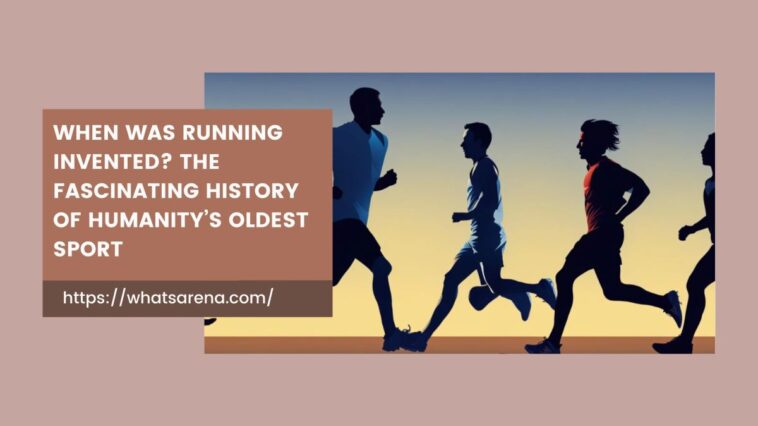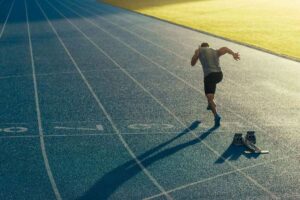Introduction
One of the most fundamental human activities is running. Millions of people globe lace up their shoes and hit sidewalks every day, whether it’s for competition, health, or sheer fun. But have you ever pondered when the invention of running happened? Running has a long history that is deeply embedded in human evolution, culture, and civilization. We’ll delve deeply into the intriguing background of the getting in this piece, including everything from its evolutionary beginnings to its relevance now.
Key Milestones in the History of Running
| Period | Event/Development | Significance |
| quite a while back | Development of Bipedalism | Empowered early people to walk and in the long run on two legs |
| Ancient Times | Ingenuity Hunting | Running is utilized as a step-by-step process for surviving worn-out prey |
| 776 BCE | First Old Olympic Games | Running occasions like the stadion became fundamental to Greek culture |
| Old Greece | Pheidippides’ Run | Roused the production of the cutting edge long distance race |
| 1896 | First Present day Olympic Long distance race | Once again introduced the long-distance race as a worldwide serious occasion |
| 1960s-1970s | Running Blast | Running turned into a famous sporting movement around the world |
| 2000s-Present | Mechanical Advances in Running | Presentation of GPS, running applications, and high-level footwear |
The Evolutionary Origins of Running
The Role of Bipedalism in Running
Running Invented evolved as a human activity after our ancestors’ developmental move from four-legged walking to two-legged walking, or bipedalism. Between four and six million years ago, was a turning point that provided the groundwork for the evolution of running. The ability to walk upright was a feature that allowed early hominins, such as Australopithecus, to perform different duties with their hands and to travel greater distances with greater efficiency.
Running in Prehistoric Times
Running Invented was as a way to survive in addition to a means of travel in the ancient era. According to the “persistence hunting” idea, early humans used a knack for running long distances to finish their prey. Humans, in contrast to many other animals, could run at an even pace for hours on end, following prey until they were too tired to flee. Being able to run for a long amount of time was vital for survival in the hostile climate of the time.
Running in Ancient Civilizations
Running in Ancient Egypt
While the ancient Egyptians are best known for their beautiful pyramids and advanced society as a whole Running Invented was also a vital component of Egyptian culture. To establish their divine right to govern and to display their athletic abilities, pharaohs would compete in ceremonial running competitions. These activities, which emphasized the relationship between physical prowess and inner strength, were frequently an element of larger celebrations of faith.
Running in Ancient Greece
The greatest-known early runners might have been the Greeks. Running Invented was as a way of life in Greece, not just a sport. Beginning in 776 BCE, running sports was a major component of the ancient Olympic Games. One of the most prestigious events was the stadium, a short sprint. In addition, the modern midway—still considered one of the most hard and important races in the globe today—was inspired by the ancient legend of Pheidippides, who raced from Marathon to Athens to spread the phrase of victory in battle.
Running in Ancient Rome:
While the Greeks are credited with creating many immigrants, the Romans quickly adapted and adopted them. In ancient Rome, running was closely connected to military training. Roman soldiers had to jog vast distances while wearing full armor to prepare for battle. viewers running races were also a usual form of entertainment, allowing the wider audience to see the runners’ endurance.
Running in Indigenous Cultures
The Tarahumara of Mexico
Mexican indigenous individuals known as the Tarahumara are renowned for their amazing endurance Running Invented. They often run extremely large distances over challenging terrain in their daily lives. Running Invented is not just a physical exercise for the Tarahumara tribe; it carries important historical and religious significance. Researchers and runners all through the world have been intrigued by the ability to run for hours or even days.
Running in Native American Cultures
Rich running traditions have become a part of many Native American cultures. Some saw it as a way for people to interact with runners posing as go-betweens for far-flung communities. Running was used in ceremonial ceremonies or had spiritual significance in some tribes. These customs show the many roles that running has had in Native American societies across the Americas.
Running in the Middle Ages
The Decline and Transformation of Running
In the Middle Ages, running declined in importance as other forms of physical activity, such as jousting and horse riding, became more popular, especially among European nobles. However, the run was not completely lost. In rural areas, the horse continued to be a means of transportation and communication, especially for those who could not afford horses. As time goes on, running is seen less as a life skill and more as a hobby for ordinary people.
Running in the Modern Era
The Birth of Organized Sport
The 18th and 19th centuries marked the beginning of running as an organized sport. The rise of running clubs and formal competitions in Europe and North America transformed running from an activity to a competition. These early events laid the foundation for the development of new sports and formalized distance and competition rules.
The Revival of the Marathon
The new long-distance race was motivated by the narrative of the old Greek Pheidippides and got back to the new Olympic Games in 1896. also, the human soul. Today, long-distance races are held from one side of the planet to the other, drawing in huge numbers of members and onlookers consistently.
Running as a Popular Fitness Activity
During the 1960s and 1970s, running was a ridiculously well-known unwinding sport, especially in the US. Running became well known as of now, named the “running blast,” as additional people found its medical advantages. Running gained popularity as a fitness performance since it was accessible to nearly all, unlike other sports that required particular tools or facilities.
Running in Contemporary Culture
The Growth of Running Events
In ongoing many years, the number and assortment of running occasions have developed dramatically. From full long-distance races and ultramarathons to more limited races like 5Ks and Noble Cause fun runs, there’s something for everybody. These occasions frequently unite different gatherings, cultivating a feeling of the local area and a common perspective. The ascent of virtual races has likewise permitted more individuals to take part, no matter what their area.
Technological Advances in Running
Innovation significantly affects how we run. Propels in Running Invented shoes, with highlights intended to upgrade execution and lessen injury, have made running more agreeable and open. Wearable innovation, for example, GPS watches and wellness trackers, permits sprinters to screen their exhibition continuously, keep tabs on their development, and enhance their preparation schedules. Running applications offer customized preparing plans, interface sprinters with virtual networks, and even reenact race conditions, impacting how we approach the game.
The Future of Running
Looking ahead, running is likely to continue evolving, driven by ongoing technological innovations and shifting cultural trends. Savvy clothing with implanted sensors, computer-generated reality Running Invented encounters, and, surprisingly, further developed running shoes are only a couple of the conceivable outcomes. As individuals become more aware of well-being and the climate, running — being both a low-influence practice and a maintainable type of transportation — may keep on filling in prevalence.
Conclusion
From the earliest long periods of human advancement to the cutting-edge Running Invented society that traverses the globe, running plays had an essential impact on our set of experiences. It has developed from an endurance component to a cutthroat game, and presently to a famous wellness action that millions appreciate. The tale of running is a demonstration of human perseverance, versatility, and the profound association between actual development and social articulation.
FAQs
1-When did humans start running?
People started going around 4 to a long time back, soon after developing to walk upstanding.
2-What is the significance of running in ancient cultures?
Running Invented was focal in old societies for customs, contests, and as a showing of physical and otherworldly power.
3-How has running evolved as a sport?
Running developed from an ability to survive to a well-known cutthroat game, particularly with the cutting-edge restoration of the long-distance race.
4-What are the health benefits of running?
Running works on cardiovascular well-being supports weight the board, and lifts mental prosperity.
5 -How is technology influencing modern running practices?
Innovation upgrades running with cutting-edge footwear, GPS following, and customized preparing applications.





